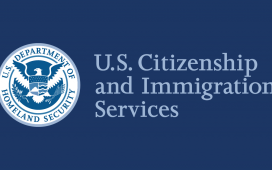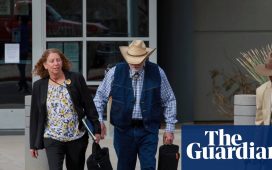Jam-packed plastic “pods” doubling as makeshift border enforcement facilities within large tents. Young migrants laying side by side on cheap floor mats. The dystopian glint of silver mylar blankets.
Alarming images that emerged from US-Mexico border detention this week are painting a nightmarish picture of the deepening humanitarian problem there, as the Biden administration frantically tries to process thousands of children and families.
The struggle to transform chaos into order has erupted amid the ongoing pandemic and a system rendered dysfunctional by the former president Donald Trump.
“It’s an incredible number of people that are coming in,” said Daniela Sosa, the community engagement and public relations manager at the Good Neighbor Settlement House, a nonprofit that’s helping to feed migrants in Brownsville, at the eastern end of the Texas-Mexico border.

US Customs and Border Protection (CBP) encountered nearly 9,500 children who came to the country unaccompanied by a parent or guardian in February – an average of 337 kids a day – as well as more than 19,000 migrants traveling as families.
By last week, more than 14,000 unaccompanied children were reportedly in federal custody, many of them inundating the Department of Health and Human Services’s office of refugee resettlement (ORR) tasked with their care.
That infrastructure, which the Trump administration set about dismantling, is now backed up. So children are stranded in inhospitable, makeshift border enforcement facilities, where experts and officials say they don’t belong, sometimes for more than 10 days.

“Border patrol stations are not meant to hold children long-term,” according to CBP, and “even a few hours in custody is more than we want”. But transferring children to ORR is “directly tied to available space” in that shelter system, which has been limited amid the public health crisis.
In rare images leaking out, which the Texas Democratic congressman Henry Cuellar’s office shared with the media, migrants can be seen languishing in cramped conditions at a CBP temporary overflow facility in Donna, Texas.
Journalists have been denied access inside that facility in recent days. The images showed youngsters sleeping on floor mats lined up close together, and covering themselves with mylar blankets to stay warm.
On Tuesday CBP issued its own images and clips, showing some similar scenes.
Those photos – captured over the weekend and first published by Axios – provide a stark glimpse into the controversial CBP holding cells that the homeland security secretary, Alejandro Mayorkas, has said are “no place for a child”, even as thousands of kids are getting stuck there well past the legal time limit of 72 hours.
“The facilities are just not appropriate places for children to spend any significant amount of time,” said Mark Greenberg, director of the human services initiative at the Migration Policy Institute, a Washington DC thinktank.

Even ORR’s placements are oftentimes just a stopover. The ultimate goal is for unaccompanied children going through immigration proceedings to be unified with parents or loved ones living in the US, but before that can happen, any potential sponsor must be vetted to ensure kids stay safe.
The worst-case scenario – which is infrequent, but has happened – is children being handed over to human traffickers after the government fails to do due diligence.
“The procedures … are sometimes called red tape, but they’re there because the agency wants to minimize the risk of putting a child in a dangerous situation,” Greenberg said.
The recent influx of vulnerable migrants at the US-Mexico border marks a departure from most of last year, when Trump used Covid-19 as a pretext to effectively shut out asylum seekers and others.
Although Mayorkas has insisted still that “the border is closed“, he has also rejected a Trump-era practice of expelling thousands of unaccompanied kids, saying “we just won’t do that”.
“That’s not who we are,” Mayorkas told NBC’s Meet the Press on Sunday.
His department continues to expel the vast majority of single adults, who represent the lion’s share of migrants encountered at the southern border.
But its policy toward families has been less uniform, a lack of consistency that the administration has blamed on Mexico’s inability to receive families.
Last month, fewer than half of migrants who traveled as a family were expelled. In an uneven return to pre-pandemic policy, others have been allowed to come into the country while they await their immigration court hearings.
As US officials try to reduce the amount of time migrants spend in custody, some are even being released without a set court date, NBC News reported.
Among migrants who are expelled – including children within families – despair manifests in tears and wails after they spend their life’s savings and risk an arduous journey to the border, only to wind up in dangerous Mexican cities instead of the US.
But those who do get in are receiving some help with immediate needs as they prepare for their court cases.
“We’ve seen how generous these people are, and how much gratitude they have whenever we show up with these warm meals,” Sosa of Good Neighbor Settlement House said.
Diapers, baby formula, toothbrushes, face masks, nail clippers, breakfast, lunch and dinner: the non-profit has been providing food and assistance for migrants as they make their way to out-of-town sponsors.
“They’re so thirsty, they’re so hungry,” Sosa said. “They’re so happy to be in the United States – that they finally made it.”






